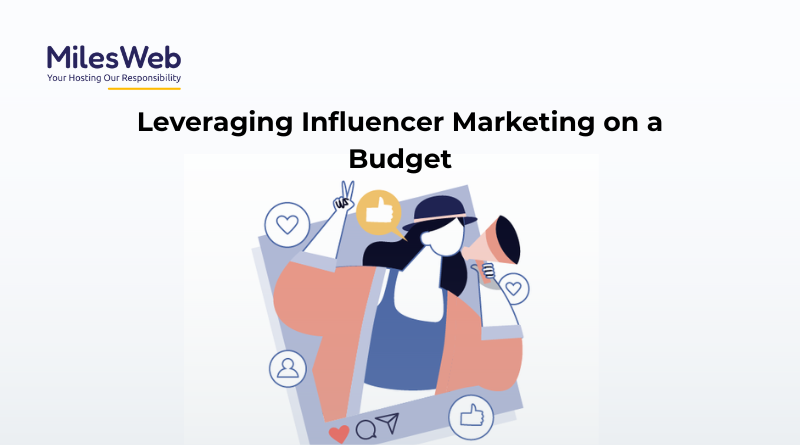Leveraging Influencer Marketing on a Budget
Did you know that, according to 89% of digital marketers, the return on investment (ROI) gained from influencer marketing is equivalent to or a lot better than traditional marketing channels? And also, influencer marketing is no longer solely limited to the top brands with sufficient capital. But it has become a smart marketing option for brands on a tight budget.
You can fuel your online growth without heavy ad spending, irrespective of whether you’re planning to host your web application on a React hosting server or handle your blog through Linux shared web hosting.
By leveraging the right strategies, small businesses can also benefit from micro-influencers to increase online visibility, drive more engagement, and earn big results with small budgets.
This blog will guide you to understand what influencer marketing is on a small budget and how small businesses on a budget can leverage influencer marketing campaigns.
What is Influencer Marketing on a Budget?
Influencer marketing on a budget can be considered a budget-friendly strategy that makes use of influencers’ potential for the purpose of promoting a brand or product with minimal spending.
Contrary to the traditional influencer marketing strategies, which normally include prominent personalities, small-budget influencer marketing emphasizes micro-influencer marketing and cost-effective influencer collaboration.
By partnering with micro-influencers with smaller yet highly loyal followers, businesses can drive effective outcomes by running cost-effective campaigns and affordable marketing methods.
Sprout Social reports that leveraging this influencer marketing approach significantly drives more engagement at the top of the funnel but also strengthens brand loyalty and influence.
Creating Successful Low-Budget Influencer Marketing Campaigns
1. Set precise goals
Once you finalize a low-cost collaboration deal with an influencer(s), before moving ahead, it is important to create a clear and concise plan, just like a roadmap. Understanding your goals is absolutely necessary.
Try to imagine it this way:
- What is your ultimate goal? Do you want more sales? More followers? or
- What’s your end goal? More sales? Bigger following? Better brand image? Or a stronger brand image?
Be specific while answering these questions.
Find out how well you’re doing by tracking the progress of your campaign(s) and, if required, make the necessary changes.
In this way, you can determine whether your marketing efforts are paying off or not.
2. Developing Compelling Content
If you want your low-cost influencer marketing to be productive, it is necessary to create relatable and impactful content that strikes a chord with your audience.
We’re sharing some prominent tips to help you generate engaging content that aligns with your audience’s preferences and drives more sales:
- Know Your Audience: Understand their pain points.
- User Needs: Understand the needs of your users.
- Communicate in Their Language: Use language that matches your audience.
- Design Attention-Grabbing Headlines: Drive more audience by designing attention-grabbing and powerful headlines.
- Segment Text in Paragraphs: To increase the readability, divide the text into headings, subheadings, and bullet points, and leave white spaces in between sections.
- Visually Appealing: Add captivating images, videos, and infographics for visual appeal.
- Design Clear-cut Call to Action: Encourage the audience to take action by designing a powerful call to action.
- Monitor Performance: Keep track of vital elements such as engagement, shares, and conversions.
3. Monitor Influencer Campaign Performance
Do you want to know whether your influencer campaign is paying off? Regularly monitor its performance by tracking the following metrics:
- User Engagement: Calculate users who interacted with your campaign through likes, comments, and shares.
- Reach of Your Campaign: This metric calculates the total number of individuals who were exposed to the campaign.
- Impressions: It calculates the number of times your content was displayed.
- Click-Through Rates: It provides insights on how many people clicked on the links shared in the influencer’s post.
- Web Traffic: Check how much website traffic has increased from the campaign.
- Total Conversion: Track sales and leads created through the campaign along with other elements.
- ROI (Return on Investment): It calculates the profits attained based on your investment.
4. Use Analytics Tools
To get valuable insights about website traffic, conversions, and revenue, you can take the help of different analytics tools such as Google Analytics, Hootsuite, and so on.
5. Measuring Return on Investment
It means calculating the profit gained from the campaign. Calculation of return on investment:
ROI = (Actual Profit / Cost of Investment) * 100
Where,
Actual Profit = Total Cost of Campaign – Total Revenue Generated
6. Analyzing and Adjusting Campaign Data
Constantly track campaign data to identify the latest trends and areas that need adjustments.
Conclusion
You don’t have to invest too much cost to get concrete results using low-cost influencer marketing. By working with micro- or nano-influencers, emphasizing user engagement, and closely monitoring performance, you can craft budget-friendly campaigns that connect with your target audience. With the right approach and a little creativity, even the smallest brands can make it big. Start your campaign wisely, remain consistent, and achieve your goals.


